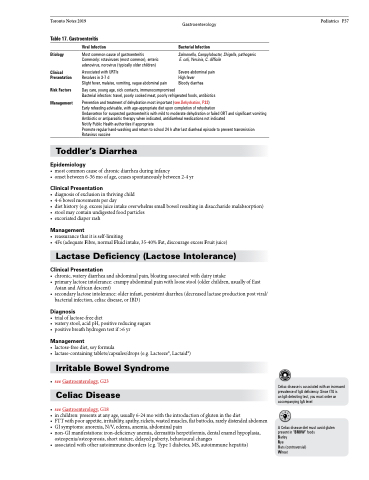Page 1071 - TNFlipTest
P. 1071
Toronto Notes 2019
Gastroenterology
Pediatrics P37
Table 17. Gastroenteritis
Etiology
Clinical Presentation
Risk Factors Management
Viral Infection
Most common cause of gastroenteritis Commonly: rotaviruses (most common), enteric adenovirus, norovirus (typically older children)
Associated with URTIs
Resolves in 3-7 d
Slight fever, malaise, vomiting, vague abdominal pain
Bacterial Infection
Salmonella, Campylobacter, Shigella, pathogenic E. coli, Yersinia, C. difficile
Severe abdominal pain High fever
Bloody diarrhea
Day care, young age, sick contacts, immunocompromised
Bacterial infection: travel, poorly cooked meat, poorly refrigerated foods, antibiotics
Prevention and treatment of dehydration most important (see Dehydration, P32)
Early refeeding advisable, with age-appropriate diet upon completion of rehydration
Ondansetron for suspected gastroenteritis with mild to moderate dehydration or failed ORT and significant vomiting Antibiotic or antiparasitic therapy when indicated, antidiarrheal medications not indicated
Notify Public Health authorities if appropriate
Promote regular hand-washing and return to school 24 h after last diarrheal episode to prevent transmission Rotavirus vaccine
Toddler’s Diarrhea
Epidemiology
• mostcommoncauseofchronicdiarrheaduringinfancy
• onsetbetween6-36moofage,ceasesspontaneouslybetween2-4yr
Clinical Presentation
• diagnosisofexclusioninthrivingchild
• 4-6bowelmovementsperday
• diethistory(e.g.excessjuiceintakeoverwhelmssmallbowelresultingindisaccharidemalabsorption) • stoolmaycontainundigestedfoodparticles
• excoriateddiaperrash
Management
• reassurancethatitisself-limiting
• 4Fs(adequateFibre,normalFluidintake,35-40%Fat,discourageexcessFruitjuice)
Lactase Deficiency (Lactose Intolerance)
Clinical Presentation
• chronic,waterydiarrheaandabdominalpain,bloatingassociatedwithdairyintake
• primarylactoseintolerance:crampyabdominalpainwithloosestool(olderchildren,usuallyofEast
Asian and African descent)
• secondarylactoseintolerance:olderinfant,persistentdiarrhea(decreasedlactaseproductionpostviral/
bacterial infection, celiac disease, or IBD)
Diagnosis
• trialoflactose-freediet
• waterystool,acidpH,positivereducingsugars • positivebreathhydrogentestif>6yr
Management
• lactose-freediet,soyformula
• lactase-containingtablets/capsules/drops(e.g.Lacteeze®,Lactaid®)
Irritable Bowel Syndrome
• seeGastroenterology,G23 Celiac Disease
• seeGastroenterology,G18
• inchildren:presentsatanyage,usually6-24mowiththeintroductionofgluteninthediet
• FTTwithpoorappetite,irritability,apathy,rickets,wastedmuscles,flatbuttocks,rarelydistendedabdomen
• GI symptoms: anorexia, N/V, edema, anemia, abdominal pain
• non-GImanifestations:iron-deficiencyanemia,dermatitisherpetiformis,dentalenamelhypoplasia,
osteopenia/osteoporosis, short stature, delayed puberty, behavioural changes
• associatedwithotherautoimmunedisorders(e.g.Type1diabetes,MS,autoimmunehepatitis)
Celiac disease is associated with an increased prevalence of IgA deficiency. Since tTG is
an IgA-detecting test, you must order an accompanying IgA level
A Celiac disease diet must avoid gluten present in “BROW” foods
Barley
Rye
Oats (controversial) Wheat


